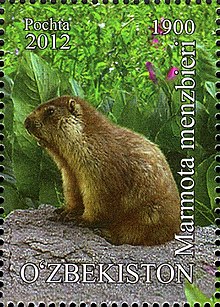Menzbier's marmot
| Menzbier's marmot | |
|---|---|
 | |
| On Uzbek stamp | |
Conservation status | |
| Scientific classification | |
| Domain: | Eukaryota |
| Kingdom: | Animalia |
| Phylum: | Chordata |
| Class: | Mammalia |
| Order: | Rodentia |
| Family: | Sciuridae |
| Genus: | Marmota |
| Species: | M. menzbieri |
| Binomial name | |
| Marmota menzbieri (Kashkarov, 1925) | |
The Menzbier's marmot (Marmota menzbieri) is a species of rodent in the family Sciuridae from Central Asia. Its name commemorates Russian zoologist Mikhail Aleksandrovich Menzbier.
Distribution and habitat
It inhabits meadows and steppe at altitudes of 2,000–3,600 m (6,600–11,800 ft) in the western Tien Shan Mountains of Kazakhstan, Kyrgyzstan, Uzbekistan and far northern Tajikistan.[1][2]
Conservation
It has the smallest range among the Palearctic species of marmot and tends to occur in low densities, with a population estimate in 1998 indicating that there were a total of 22,000 individuals and an estimate in 2005 indicating that there were 20,000–25,000 individuals in Kazakhstan alone.[1][2] The IUCN considers it vulnerable with the main threat being habitat loss from expanding agriculture and a smaller threat being hunting for food.[1] Locally, its range comes into contact with that of the long-tailed marmot (M. caudata) and the two form a species group, but they segregate by habitat, with the Menzbier's marmot preferring wetter areas at a higher altitude and with shorter grass.[2]
Description
It is the smallest Palearctic species of marmot with a head-and-body length if 34.5–50 cm (13.6–19.7 in) and a weight of 1.85–5 kg (4.1–11.0 lb).[2] It is a relatively short-tailed species with a long and dense fur. Uniquely among marmots, it has dark upperparts and rear parts that contrast clearly with the pale underparts and frontal parts. Like other marmots, it gradually becomes darker overall as the season progresses.[2]
Taxonomy
The range of the Menzbier's marmot is split in two by the Pskem River and its valley. Although the two populations are very similar in their appearance, they are clearly separated genetically, leading to the recognition of the northern M. m. menzbieri and the southern subspecies M. m. zachidovi.[2] Menzbier's marmots hibernate from August or September to April or May.[2]
References
- ^ a b c d Tsytsulina, K. (2008). "Marmota menzbieri". IUCN Red List of Threatened Species. 2008: e.T12827A3386921. doi:10.2305/IUCN.UK.2008.RLTS.T12827A3386921.en. Retrieved 14 November 2021.
- ^ a b c d e f g Kryštufek, B.; B. Vohralík (2013). "Taxonomic revision of the Palaearctic rodents (Rodentia). Part 2. Sciuridae: Urocitellus, Marmota and Sciurotamias". Lynx, N. S. (Praha). 44: 27–138.
- Thorington, R. W. Jr. and R. S. Hoffman. 2005. Family Sciuridae. pp. 754–818 in Mammal Species of the World a Taxonomic and Geographic Reference. D. E. Wilson and D. M. Reeder eds. Johns Hopkins University Press, Baltimore.
- v
- t
- e
(antelope squirrels)
- Harris's antelope squirrel (A. harrisii)
- Espíritu Santo antelope squirrel (A. insularis)
- Texas antelope squirrel (A. interpres)
- White-tailed antelope squirrel (A. leucurus)
- San Joaquin antelope squirrel (A. nelsoni)
(golden-mantled ground squirrels)
- Golden-mantled ground squirrel (C. lateralis)
- Sierra Madre ground squirrel (C. madrensis)
- Cascade golden-mantled ground squirrel (C. saturatus)
(prairie dogs)
- Gunnison's prairie dog (C. gunnisoni)
- White-tailed prairie dog (C. leucurus)
- Black-tailed prairie dog (C. ludovicianus)
- Mexican prairie dog (C. mexicanus)
- Utah prairie dog (C. parvidens)
- Siberian chipmunk (E. sibiricus)
(little ground squirrels)
- Mexican ground squirrel (I. mexicanus)
- Rio Grande ground squirrel (I. parvidens)
- Thirteen-lined ground squirrel (I. tridecemlineatus)
(marmots)
- Bobak marmot (M. bobak)
- Alaska marmot (M. broweri)
- Black-capped marmot (M. camtschatica)
- Long-tailed marmot (M. caudata)
- Himalayan marmot (M. himalayana)
- Alpine marmot (M. marmota)
- Menzbier's marmot (M. menzbieri)
- Groundhog or woodchuck (M. monax)
- Tarbagan marmot (M. sibirica)
Subgenus Petromarmota: Hoary marmot (M. caligata) - Yellow-bellied marmot (M. flaviventris)
- Olympic marmot (M. olympus)
- Vancouver Island marmot (M. vancouverensis)
(western chipmunks)
- Tropical ground squirrel (N. adocetus)
- Ring-tailed ground squirrel (N. annulatus)
(rock squirrels)
- Baja California rock squirrel (O. atricapillus)
- California ground squirrel (O. beecheyi)
- Rock squirrel (O. variegatus)
- Franklin's ground squirrel (P. franklinii)
(Asian rock squirrels)
- Père David's rock squirrel (S. davidianus)
- Forrest's rock squirrel (S. forresti)
(Old World ground squirrels)
- Alashan ground squirrel (S. alashanicus)
- Brandt’s ground squirrel (S. brevicauda)
- European ground squirrel (S. citellus)
- Daurian ground squirrel (S. dauricus)
- Red-cheeked ground squirrel (S. erythrogenys)
- Yellow ground squirrel (S. fulvus)
- Russet ground squirrel (S. major)
- Caucasian mountain ground squirrel (S. musicus)
- Tian Shan ground squirrel (S. nilkaensis)
- Pallid ground squirrel (S. pallidicauda)
- Little ground squirrel (S. pygmaeus)
- Relict ground squirrel (S. relictus)
- Speckled ground squirrel (Spermophilus suslicus)
- Taurus ground squirrel (Spermophilus taurensis)
- Asia Minor ground squirrel (Spermophilus xanthoprymnus)
- Eastern chipmunk (T. striatus)
(Holarctic ground squirrels)
- Uinta ground squirrel (U. armatus)
- Belding's ground squirrel (U. beldingi)
- Northern Idaho ground squirrel (U. brunneus)
- Merriam's ground squirrel (U. canus)
- Columbian ground squirrel (U. columbianus)
- Wyoming ground squirrel (U. elegans)
- Southern Idaho ground squirrel (U. endemicus)
- Piute ground squirrel (U. mollis)
- Arctic ground squirrel (U. parryii)
- Richardson's ground squirrel (U. richardsonii)
- Townsend's ground squirrel (U. townsendii)
- Long-tailed ground squirrel (U. undulatus)
- Washington ground squirrel (U. washingtoni)
(pygmy ground squirrels)
- Mohave ground squirrel (X. mohavensis)
- Perote ground squirrel (X. perotensis)
- Spotted ground squirrel (X. spilosoma)
- Round-tailed ground squirrel (X. tereticaudus)
This ground squirrel article is a stub. You can help Wikipedia by expanding it. |
- v
- t
- e











